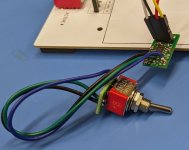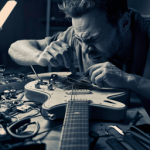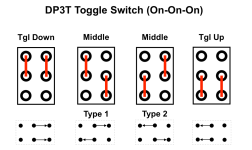JTEX
Well-known member
Input buffers, flat boosters, EQ'd boosters - they can all be built around the same basic template consisting of a noninverting op amp and a few passives around it.
I did just that, using a DIP switch for set-and-forget settings and an ON-ON-ON toggle to go between 3 main operating modes: treble boost, unity gain buffer, and bass or flat boost. With the op amp specified, the whole circuit has the same self noise as a single 4k resistor (plus whatever gain you dial in) and draws just 0.3mA (lasts >1000 hours on a 9V battery). For best results install onboard, get rid of the original 250k or 500k volume pot (you can keep the original tone pot, before the buffer), and use a 10k volume pot after the buffer instead. 25k will do if you can't find a 10k in guitar size, but 10k or even lower is preferable for lowest noise and output Z.
Equally suitable for guitar and bass.
I did just that, using a DIP switch for set-and-forget settings and an ON-ON-ON toggle to go between 3 main operating modes: treble boost, unity gain buffer, and bass or flat boost. With the op amp specified, the whole circuit has the same self noise as a single 4k resistor (plus whatever gain you dial in) and draws just 0.3mA (lasts >1000 hours on a 9V battery). For best results install onboard, get rid of the original 250k or 500k volume pot (you can keep the original tone pot, before the buffer), and use a 10k volume pot after the buffer instead. 25k will do if you can't find a 10k in guitar size, but 10k or even lower is preferable for lowest noise and output Z.
Equally suitable for guitar and bass.
Attachments
Last edited:








